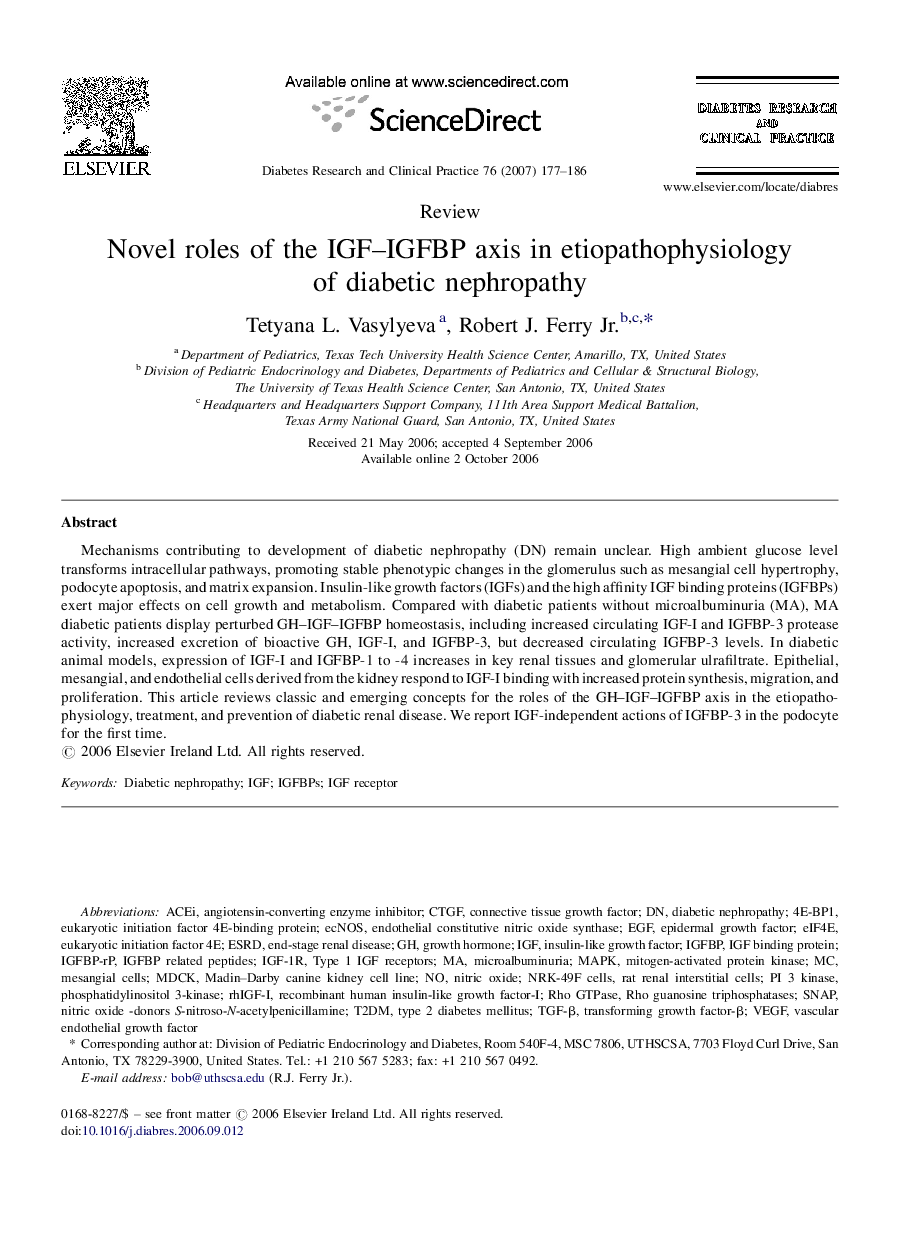| کد مقاله | کد نشریه | سال انتشار | مقاله انگلیسی | نسخه تمام متن |
|---|---|---|---|---|
| 2798886 | 1155704 | 2007 | 10 صفحه PDF | دانلود رایگان |
عنوان انگلیسی مقاله ISI
Novel roles of the IGF-IGFBP axis in etiopathophysiology of diabetic nephropathy
دانلود مقاله + سفارش ترجمه
دانلود مقاله ISI انگلیسی
رایگان برای ایرانیان
کلمات کلیدی
CTGF4E-BP1T2DMeIF4EIGF-1RMDCKRho GTPaseIGFBPIGFBPsrhIGF-IecNOSPI 3 kinaseIGFTGF-βeukaryotic initiation factor 4E-binding proteinEGFMAPK - MAPKESRD یا end stage renal disease - بیماری کلیوی در مرحله نهایی End-stage renal disease - بیماری کلیوی در مرحله پایانیtransforming growth factor-β - تبدیل فاکتور رشد βType 2 diabetes mellitus - دیابت نوع دوmesangial cells - سلول های مزانژیendothelial constitutive nitric oxide synthase - سنتاز اکسید نیتریک تشکیل دهنده اندوتلیالSNAP - ضربه محکم و ناگهانیeukaryotic initiation factor 4E - عامل آغاز کننده یوکاریوتی 4Eepidermal growth factor - عامل رشد اپیدرمیVascular endothelial growth factor - فاکتور رشد اندوتلیال عروقیVascular Endothelial Growth Factor (VEGF) - فاکتور رشد اندوتلیال عروقی (VEGF)Connective tissue growth factor - فاکتور رشد بافت همبندInsulin-like growth factor - فاکتور رشد مانند انسولینPhosphatidylinositol 3-kinase - فسفاتیدیلینواستیل 3-کینازACEI یا angiotensin convert enzyme inhibitor - مهارکننده آنزیم تبدیلکننده آنژیوتانسینangiotensin-converting enzyme inhibitor - مهارکننده آنزیم تبدیلکننده آنژیوتانسینmicroalbuminuria - میکروآلبومینوریDiabetic nephropathy - نفروپاتی دیابتیNitric oxide - نیتریک اکسیدGrowth hormone - هورمون رشدIGF binding protein - پروتئین اتصال دهنده IGFmitogen-activated protein kinase - پروتئین کیناز فعال با mitogenIGF receptor - گیرنده IGF
موضوعات مرتبط
علوم زیستی و بیوفناوری
بیوشیمی، ژنتیک و زیست شناسی مولکولی
علوم غدد
پیش نمایش صفحه اول مقاله

چکیده انگلیسی
Mechanisms contributing to development of diabetic nephropathy (DN) remain unclear. High ambient glucose level transforms intracellular pathways, promoting stable phenotypic changes in the glomerulus such as mesangial cell hypertrophy, podocyte apoptosis, and matrix expansion. Insulin-like growth factors (IGFs) and the high affinity IGF binding proteins (IGFBPs) exert major effects on cell growth and metabolism. Compared with diabetic patients without microalbuminuria (MA), MA diabetic patients display perturbed GH-IGF-IGFBP homeostasis, including increased circulating IGF-I and IGFBP-3 protease activity, increased excretion of bioactive GH, IGF-I, and IGFBP-3, but decreased circulating IGFBP-3 levels. In diabetic animal models, expression of IGF-I and IGFBP-1 to -4 increases in key renal tissues and glomerular ulrafiltrate. Epithelial, mesangial, and endothelial cells derived from the kidney respond to IGF-I binding with increased protein synthesis, migration, and proliferation. This article reviews classic and emerging concepts for the roles of the GH-IGF-IGFBP axis in the etiopathophysiology, treatment, and prevention of diabetic renal disease. We report IGF-independent actions of IGFBP-3 in the podocyte for the first time.
ناشر
Database: Elsevier - ScienceDirect (ساینس دایرکت)
Journal: Diabetes Research and Clinical Practice - Volume 76, Issue 2, May 2007, Pages 177-186
Journal: Diabetes Research and Clinical Practice - Volume 76, Issue 2, May 2007, Pages 177-186
نویسندگان
Tetyana L. Vasylyeva, Robert J. Jr.,